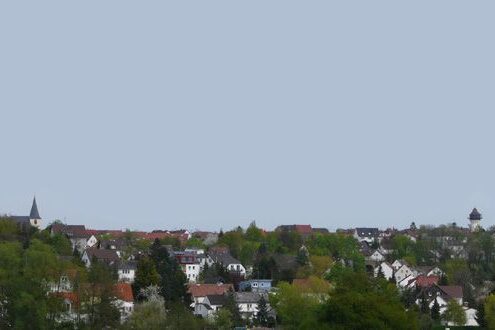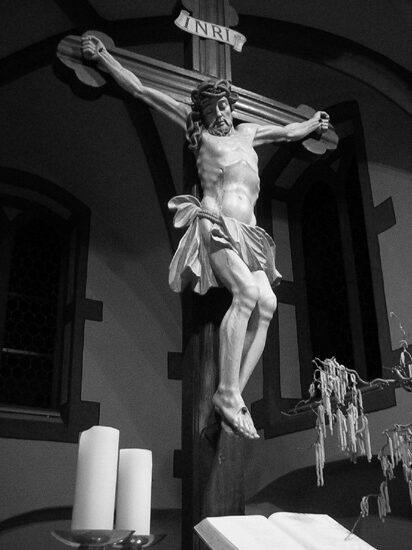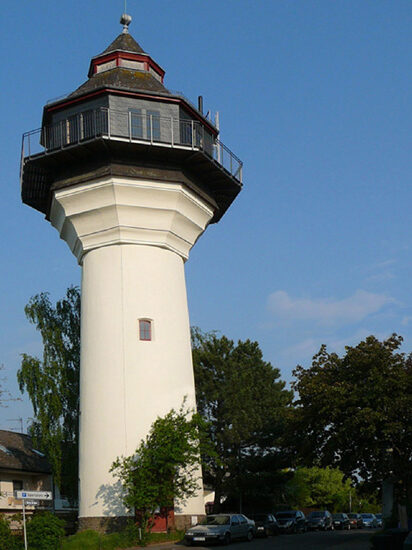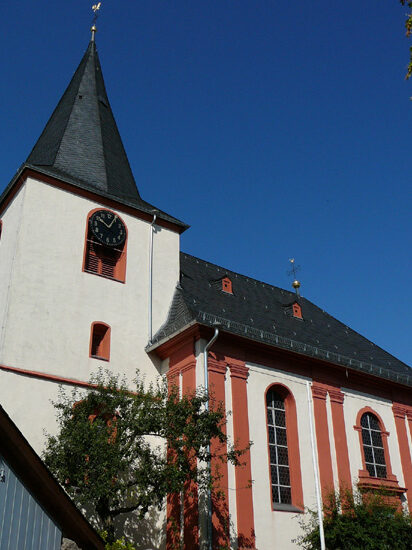Igstadt
Igstadt, a farming village, developed from its first documented mention in the 13th century into a popular suburb of Wiesbaden, which was incorporated in 1928.
The beginnings of the village of Igstadt probably date back to the documentless period of the Frankish land conquest in the 6th and 7th centuries. The place name is probably derived from a Frankish landlord "Igo" or a similar name. A fortress-like, fortified farmstead on the hill above the Wäschbach valley, situated on a main road, could have formed the nucleus for further settlements and ultimately for the establishment of the village. In 1947, during the construction of a barn, a burial ground with at least twelve burials was excavated, which can be dated to the pre-Christian period due to its location and the few grave goods found. The archaeological investigation of these graves, which has not yet been carried out, could certainly contribute to a more precise dating of the early history of the village.
The first two currently known documentary mentions of the village in 1241 and 1251 do not refer to Igstadt itself, but rather mention Igstadt residents, including the village priest Arnoldus and the mayor, as witnesses to legal transactions in neighboring communities. There are already more than twenty documents for the second half of the 13th century, in which the Mainz Altmünster monastery in particular makes an appearance. The Mainz cathedral chapter and the St. Peter's Abbey of Mainz are also mentioned as early as the 13th century with small estates in Igstadt. These documents, but above all the existence of a village priest and thus a church as well as a mayor, prove that village life was already in full swing at this time, meaning that the village was founded much earlier.
The Altmünster monastery was the largest landlord and at the same time the lord of the village, with bailiwick rights and the collatur (appointment of clergy), originally owning over 400 acres of land. How this Mainz nunnery, founded in the 8th century, came to own Igstadt is unknown. A deed of gift or a comparable document is probably lost forever, as the convent itself could only state in a property register from 1735 that it had had a free farm and the large and small tithes "in dignified possession" in Igstadt "for many years".
The first surviving property registers date back to the beginning of the 14th century. In 1305, the Gnadenthal monastery (near Camberg) received a farm with around 130 acres of land in Igstadt from the knight Dehrn, who was wealthy here and in neighbouring communities. The size of the individual rather small plots of land and the names of the neighbors can be found in the monastery's land register from 1380. At this time, there were therefore other aristocratic properties in Igstadt which are no longer documented. Both monasteries did not manage their estates themselves, or at best only for a short time, but leased them to Igstadt farmers. The leasehold contracts with the ancestors of some of the families still living in the area today can be traced almost seamlessly from the 14th to the 19th century. Other monasteries and convents in Mainz also owned land and income in Igstadt.
The nuns of the Altmünster monastery transferred the exercise of secular (bailiwick) power to the Counts of Ziegenhain, who in turn enfeoffed various knights with the Igstadt bailiwick, even before the documentary period. Most of the early documents relating to Igstadt from the 13th century deal with legal disputes between the Altmünster monastery and the lords of Bigen as local bailiffs, who pledged their Igstadt income as security for loans, as was common practice at the time. Although the Eppstein lords had sovereignty over Igstadt through the Mechthildshäuser Hoch(Blut-)Gericht (Mechthildshäuser Gericht), they did not have their own lordship here. After the Ziegenhainers died out in 1454, this county was inherited by the Landgraviate of Hesse, which now also claimed the Igstadt bailiwick for itself.
After Gottfried IX von Eppstein sold the later so-called "Ländchen" villages(Ländchen) including Igstadt to Hesse in 1492 and the introduction of the Reformation a good 40 years later, the Landgraves of Hesse-Marburg and Hesse-Kassel increasingly ousted the Altmünster monastery from its sovereign rights in Igstadt. When the Catholic priest died in 1532, the Hessian bailiff von Eppstein refused to allow the Altmünster monastery to fill the vacancy. From this time onwards, only this bailiff exercised the rights of lordship in Igstadt; in addition, apart from the tithe, he collected all previous levies connected with the local lordship from the monastery. Altmünster could continue to dispose of its land, but lost all other rights in the village. Even the monastery's lawsuit before the Imperial Chamber Court in Speyer (1580), which was actively supported by the Archbishop of Mainz, did nothing to change the actual balance of power. Towards the end of the 16th century, there were 71 families living in Igstadt.
During the Thirty Years' War, Igstadt fared no better than many neighboring communities. Between 1620 and 1634, the quarterings followed each other in close succession, food and provisions had to be delivered to distant troops and considerable sums had to be raised for (dubious) letters of protection and guards as well as for supplies to Mainz and the Rheingau. The villagers were robbed, pillaged and murdered. For example, a report to the Hessian Landgrave states that plundering soldiers cut off the head of the priest's wife in the presence of her husband. Between 1624 and 1634, the war costs in Igstadt had risen to 15,475 guilders, quite apart from the considerable damage to the land that the military must have caused. In 1637, Igstadt still had nine "Haußgeseß" and 16 "junge Leut" and in 1643, a list of inhabitants names 13 residents in addition to the parish priest, the clerk of the court and five "Wittiben". Seven years after the end of the war, in 1655, 28 farms were once again under cultivation, but the majority of the farmsteads, namely 31, still lay fallow. The Altmünsterhof with the tithe barn had also burnt down and the Altmünster monastery reduced the grain rent with the condition that the tenants restore the buildings. Between 1670 and 1672, the rectory was rebuilt and in 1677 the rectory barn, which had burnt down shortly before, was rebuilt.
Two important sources of local history begin in the 1980s, namely the records of the parish accounts, which are almost complete up to the incorporation of Igstadt into Wiesbaden in 1928, and the minutes of the appointments to the parish offices, which date back to around 1900.
In the early years of the 18th century, the Hesse-Darmstadt sovereign, who had been in power since 1651, also ordered the creation of new land registers, land measurement registers, trade registers and tithe registers in the "Ländchen". In Igstadt, 60 farmsteads with 53 houses (including two smithies, a brewery and five wine presses) and 15 "unmarried" farmsteads were recorded statistically. Despite the considerable burdens associated with the movement of troops during the many wars of the 18th century, which did not involve any fighting here but did involve quartering and oppressive contributions, Igstadt was able to replace its dilapidated church, which had become too small, with a new one between 1726 and 1728. Thanks to the ecumenical attitude of its abbess Maria Fides Peetz, the Altmünster monastery in Mainz donated a valuable baroque crucifix, which still stands above the altar today, to its former, but long since Protestant patron church for the consecration.
The Age of Enlightenment not only brought about an ecumenical way of thinking, but also cameralistics. As early as 1735, the steward of the Altmünster monastery wrote his Compendium Bilhildis, which contains important information about Igstadt's local history. In the 1970s, it had also become fashionable in the Landgraviate of Hesse-Darmstadt to compile comprehensive statistics for "soul and livestock tables". The tables for Igstadt from 1775 show that there were 350 inhabitants living in 87 households, including five single people with their own household, five widowers and 16 widows. The sons and daughters were divided into five age groups between up to five and up to 30 years. Even four unmarried people living with their parents were identified, but only four farmhands and nine maidservants. There were 76 farmsteads, a parish, council, school, shepherd's and bakehouse, two gates, 1812 acres of arable land, 76 acres of vineyards, 187 acres of meadows, 240 acres of forest, 125 acres of scrubland, 25 horses, 31 oxen, 130 cows, 19 cattle, 373 sheep and 180 pigs. The abolition of the Altmünster monastery, whose assets Prince-Bishop Friedrich von Erthal of Mainz wanted to donate to the needy University of Mainz, was also due to the spirit of the times. However, the monastery's property in Igstadt was essentially transferred to the sovereign domains, initially of the Landgraviate of Hesse-Darmstadt and later of the Duchy of Nassau.
The period between 1792 and 1814 was again overshadowed by heavy war burdens for Igstadt and the neighboring communities as a result of the battles for the fortress of Mainz in the Revolutionary Wars. In the total period from 1792 to 1806, Igstadt incurred war expenses amounting to over 26,000 guilders. The time was particularly bad when the defeated French army poured back into the then French city of Mainz in late 1813, followed by Prussian and other German units, which also took up positions in the Rhine-Main region for the attack on France on New Year's Eve 1813/1814. Due to the massive quartering of 950 men with around 1000 horses, the cost of the war for Igstadt during this short period amounted to over 47,000 guilders.
The 19th century brought far-reaching changes to the old agricultural structures in Igstadt, as in the whole of Nassau. The abolition of all "medieval" taxes such as carnival hens, Weidhämmel, Jagdthaler, Schützenkorn and the like was overdue, as was the abolition of land charges and tithes; they were replaced by a new (modern) tax system with land taxes, trade and income taxes.
New techniques of land cultivation and a major land consolidation were important for increasing agricultural yields. Igstadt grew from around 480 inhabitants in 1817 to around 750 inhabitants at the end of the 19th century. As early as the middle of the century, the municipality had planned a major expansion of the village with around 50 building plots on an area of around 25,000 square meters, but this was never implemented. The village received a new school (1821), a larger cemetery on the outskirts of the village (1857) and, above all, a connection to the railroad line from Wiesbaden to Niedernhausen (1879).
At the beginning of the 20th century, Igstadt was still a farming village with around 760 inhabitants in the outskirts of the cosmopolitan spa town of Wiesbaden. There was no electricity or sewage system, drinking water was drawn from wells and the roads were gravel. At the end of the century, Igstadt, which had long since become a district of Wiesbaden with a modern infrastructure, had around 2100 inhabitants, but only six full-time farms. Between the turn of the century and the First World War, Igstadt had already seen some changes. After the damaged church tower was replaced in 1901, the interior of the nave was renovated and a new organ was built in 1904. In 1910, the community was able to put its first own water supply system into operation. The waterworks were built in the Wickerbachtal valley to the west of the Igstadt-Medenbach district road and the 27-metre-high water tower was erected on the outskirts of the village in the "Vorm Graben" district. The very next year, the power supply was provided by a ten-kilovolt overhead line and a transformer station on Breckenheimer Straße. Work began on expanding the local network and installing street lighting. And one year before the outbreak of the First World War, the people of Igstadt received a new station building, which today looks pretty and somewhat nostalgic.
The First World War also claimed victims in Igstadt; 38 of the men from the village who took part in the war never returned home. A memorial stone in front of the cemetery gate bears their names. After the end of the war, not only was the town of Wiesbaden occupied by foreign troops, Igstadt was also quartered, first French (until mid-September 1919), then British (including Scots). In April 1924, the association "Siedlervereinigung Eigenes Heim Igstadt b. Wiesbaden e.V." was founded in response to the general housing shortage. It supported its members, 19 people willing to build, in all phases of house construction, from the purchase of land to planning and financing. In the following years, 16 semi-detached houses and three detached houses were built on what was then Friedrich-Ebert-Straße, formerly Schafsweide am Wäschbach and today Florian-Geyer-Straße. As a special event in 1927, the local chronicle records the purchase and consecration of new church bells. In 1928, Igstadt was incorporated into Wiesbaden together with the neighboring communities of Erbenheim, Bierstadt and Kloppenheim on the basis of an imperial law. However, the people of Igstadt had to fight for this, as the draft law provided for Igstadt to be incorporated into the new Main-Taunus district. It was not only the close economic ties with Wiesbaden, from jobs to road construction and maintenance issues, but also the strong orientation of almost all areas of life towards Wiesbaden that prompted the citizens to hold protest meetings and resolutions. In the end, Mayor Müller and teacher Schimmel succeeded in achieving the incorporation into Wiesbaden (incorporations) "at the last minute", i.e. shortly before the second reading of the law, through talks with members of parliament in Berlin
Being part of the city brought many advantages, e.g. the connection to the municipal gas supply and the replacement of the compulsory fire department with a voluntary fire department. A bus connection to Wiesbaden had already existed since 1927. Igstadt received its first sports field in 1929 and the last vineyard was cleared. The first kindergarten was set up on the upper floor of the town hall in 1934. In the 1930s, Igstadt still had 44 milk-producing farms. As in the neighboring villages, the rise of National Socialism found supporters in Igstadt early on. In 1927, the first National Socialists gathered in an Igstadt inn, and in 1930 a cell of the NSDAP was formed, which had developed into a local group by 1938. Several Jewish families in Igstadt were forced to sell their homes and leave the town. As the period from the early 1930s to the end of the Second World War has not yet been sufficiently researched in terms of local history, a more in-depth account must be reserved for a later publication. Igstadt was also affected by the bombing raid on Wiesbaden in the night from February 2 to 3, 1945; a residential building with a restaurant and several barns were destroyed. During the war, 88 Igstadt residents lost their lives.
The immediate post-war period also brought cramped living conditions as well as restrictions and shortages of all kinds for Igstadt. But in the 1950s, as elsewhere, a new development was noticeable. The population, which had been stated as 1092 shortly before the war, had increased to 1477 by 1950 and to 1642 by 1965 - not least due to the influx of displaced persons. The sculptor Horst Panknin, who was born in Königsberg, also found a new home in Igstadt with his family in 1960.
Road traffic increased so much that the old town hall had to be demolished in 1957 due to traffic obstructions, as buses and trucks had difficulty passing through Igstadt. The new school building had already been occupied in 1954; in 1958, a new fire station was built on the site of the old one, which had become too small. Club life flourished with new foundations and re-establishments, not forgetting the Igstadter Kerb, which was again celebrated extensively. Trade and commerce flourished in Igstadt, with the retail and hospitality sectors in particular being represented by small businesses that have almost completely disappeared today. In addition to eight inns, there were no fewer than six (mostly small) grocery and general stores (so-called colonial goods stores), two bakers and three butchers.
The development of new building areas began as early as the end of the 1950s. Igstadt was not only growing on the outskirts of the village (at a moderate rate compared to neighbouring villages and to the delight of the locals), but there were also positive developments in the village center in particular: since 1984, the village council had been working on the redevelopment of the village center, which was listed as a historical monument in 1988 and thoroughly renovated in the following decade, both by restoring old, half-ruined farmhouses and by increasing the density of buildings in the farmyards that were no longer used for agricultural purposes. Since 1949, the local council has been composed in such a way that the SPD has been the local chairman nine times, the CDU three times and the FDP once. Fifteen city councillors from Igstadt were involved in Wiesbaden city politics. Today, the fertile Igstadt district is farmed by only a few full-time farmers. In 2009, statistics recorded 177 registered businesses in the town, mainly small companies, including those in the "modern" service sectors. Most of the residents found their jobs in Wiesbaden and the rest of the Rhine-Main region. Compared to the Wiesbaden average, the unemployment rate here is only half as high, the elderly rate is lower and the child rate is higher. Igstadt is and remains a popular and sought-after place to live at a lofty height in the east of the state capital Wiesbaden.
Literature
- Heimat- und Geschichtsverein Igstadt
Igstadter Geschichte(n), Chronik 1. from the beginnings to the 19th century, Wiesbaden 2008.
- Heimat- und Geschichtsverein Igstadt
Igstadt history(ies). From farming village to urban district - the 20th century. Chronicle 2, Wiesbaden 2009.



